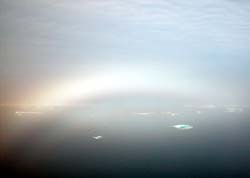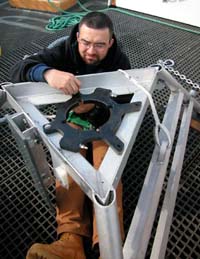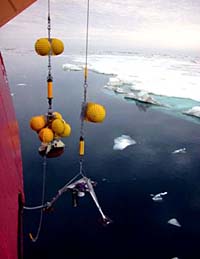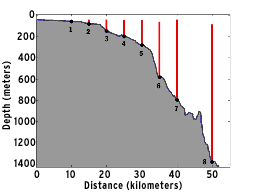|
|
 |
 |
 |
|
As we drifted in and out of the fog today, we witnessed this incredible fogbow. |
|
Click to enlarge |
 |
|
Dan Torres gets into setting up the tripod mooring - literally. |
|
Click to enlarge |
 |
|
Both the tripod mooring and its acoustic release went over the side simultaneously during this complicated deployment. |
|
Click to enlarge |
 |
|
This cross-section across the Beaufort slope shows the final positions of the WHOI mooring array. The gray area is the ocean bottom and the red lines are the moorings. Note that they don’t extend all the way to the surface - this is because we want to keep the instruments away from the shifting ice pack. |
|
Click to enlarge |
Daily Update
Calendar
Dispatch 18 - August 1, 2002
By C.A. Linder
Weather conditions: overcast skies, wind 10 knots from the SW, calm seas, air temperature 44° F.
Hole in One
Elated, relieved, and amazed. Those are the words Bob Pickart used this evening to describe his feelings when the eighth and final WHOI mooring went into the water. It was handshakes all around for the tired deck crew and science mooring team. The Arctic Ocean has dealt us our fair share of setbacks, but at the end of a long hard week, we have a perfectly positioned set of moorings spanning the Beaufort shelf and slope, all dutifully collecting our data (we hope!) for the next 13 months.
The mooring crew, fighting the exhaustion of the past few days, was up and ready for action again by breakfast. As in the past few mornings, the weather was raw, and a damp fog engulfed the ship. Thankfully, as we steamed south through the night the ice had become more and more dispersed, so it was no trouble finding a safe, ice-free mooring location. Watching from the fantail of the ship, I could feel the growing camaraderie between the science team and the Polar Star’s deck crew - they made this complicated and sometimes dangerous task look easy. Number seven was in the water.
Number eight was a completely different story. John Kemp elected to deploy the moorings in order of deepest to shallowest so that the team would have lots of practice working together; this last one was much more complex. Before the operation began, though, some assembly was required. The previous seven moorings were traditional type moorings in the sense that an anchor is used to hold the mooring to the bottom, and a series of floats keeps the line of instruments aligned in a taut vertical line (for a diagram of a traditional mooring, click here). The mooring is essentially assembled “on the fly” - as the line is let out over the stern of the ship, the instruments are attached one by one. This final mooring, however, was a “tripod” type. Instead of being attached to a line, the instruments are attached to a metal tripod about four feet high which rests on the seafloor. We chose this type of mooring to get measurements very close to the bottom on the shallow Beaufort shelf. It took several hours of hard work for John Kemp and Dan Torres to get the instruments attached to the tripod and to set up the acoustic release device which will bring the tripod back to the surface when we return next year. After a quick dinner, John assembled the mooring crew on the fantail.
It seemed to me that this would be a really easy mooring to put in the water - you just push that tripod over the side, and that’s it, right? Well, it’s not quite that easy! In fact, it was the most dangerous job the mooring crew has had to deal with yet. Although it was so complicated that I’m still not quite sure how it all worked, the mooring crew put in the tripod so expertly that it was dropped within yards of its target location. In oceanography, that’s the equivalent of a hole in one! In lieu of champagne, everyone celebrated by turning in early for some well-deserved rest.
 Previous Dispatch
Next Dispatch Previous Dispatch
Next Dispatch

Back to Calendar
|
|




